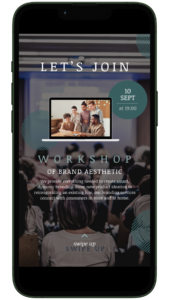Workshops have emerged as a pivotal tool in strategic planning, offering a vibrant stage for ideation, collaboration, and achieving targeted outcomes. Whether it’s a traditional in-person event or the unique demands of a virtual workshop, the objective is consistent: to conduct an effective workshop that engages participants and fulfills the desired strategic plan. This guide, enriched with insights on using the digital invitation app Hobnob, will outline the essentials of workshop planning, from strategic planning to workshop preparation, ensuring your event is both successful and memorable.
It emphasizes the importance of engaging workshop attendees, including key stakeholders, workshop facilitators, and participants, highlighting how Hobnob can streamline organizing these groups. The guide also discusses setting measurable workshop goals, creating engaging agendas, and the significance of activities in the strategic planning process. It touches on the nuances of virtual workshops, emphasizing the best practices for remote engagement.
Concluding with insights on facilitating impactful workshops, this guide ensures a comprehensive understanding of the planning process, using digital tools like Hobnob for effective management, and the steps necessary for a successful, memorable workshop.
The Essence of Workshop Planning
Planning for workshops is a complex and multifaceted process that necessitates meticulous organization, strategic thinking, and careful attention to detail. It involves not just the basic logistics of event planning but also a deep understanding of the workshop’s core objective. This understanding is crucial in shaping every aspect of the workshop, from the design of each activity to the flow of discussions and the structure of each session. Ensuring that these elements cohesively align with the workshop’s primary goal is fundamental to the success of the event.
A successful workshop requires more than just a good plan; it demands strategic planning workshop techniques that take into account various factors such as the targeted outcome, the needs and expectations of the participants, and the overall context of the workshop. This starts with setting a clear and comprehensive workshop agenda that meticulously outlines the timeline, topics, and activities planned. This agenda serves as a roadmap, guiding both facilitators and participants through the workshop’s journey.
Selecting the right venue is another critical aspect of workshop planning. The venue should not only accommodate the size of the group but also cater to the specific requirements of the workshop’s activities and sessions. Whether it’s a traditional in-person workshop or a virtual workshop, the environment plays a significant role in influencing participant engagement and interaction.
In addition to these elements, the planning process also involves considering the various roles within the workshop, such as the workshop facilitator, leader, or stakeholder. These individuals are key in driving the workshop forward, ensuring that the discussions remain focused and productive, and that the workshop’s objectives are achieved.
Furthermore, a strategic planning process often includes elements like project management, stakeholder involvement, and participant feedback. This involves not only managing the logistical aspects of the workshop but also ensuring that the content and delivery are relevant and engaging for the attendees.

Leveraging Technology with Hobnob

In the digital age, technology is crucial for enhancing workshop experiences, and Hobnob, our digital invitation app, is a perfect example of this. It revolutionizes workshop planning by allowing seamless communication with guests. With Hobnob, you can effortlessly chat with attendees, collect RSVPs, manage photos, and send instant text updates, all within a single platform.
This app simplifies communication, making it easier to organize groups and keep in touch with participants. The ability to collect RSVPs streamlines participant management, while the photo-sharing feature enriches the post-workshop engagement. Instant text updates ensure timely and efficient information dissemination, crucial for a well-coordinated event.
Overall, Hobnob enhances the workshop experience, integrating seamlessly into the strategic planning process, making it more connected, organized, and engaging for everyone involved.
Engaging Participants: The Heart of Your Workshop
The success of a workshop is intrinsically linked to its participants. Their engagement, from the initial stages of the workshop planning to the final moments of the event, is pivotal. To achieve this, it’s essential to captivate workshop attendees right from the start, which begins with a strategic and well-thought-out invitation process. Utilizing Hobnob, a digital invitation app, can significantly enhance this phase. Crafting an inviting and informative digital invitation not only sets the tone for the workshop but also demonstrates a commitment to a professional and organized event. This initial interaction can pique the interest of potential attendees and build anticipation for what’s ahead.
Once the workshop is underway, participant engagement becomes the driving force of the event. Involving attendees in group discussions is a key strategy. These discussions can be structured to encourage open communication, sharing of ideas, and collaboration among participants. This approach not only fosters a sense of community but also helps in gathering diverse perspectives and insights.
Ideation sessions are another crucial component in engaging participants. These sessions should be designed to stimulate creativity and innovation, allowing participants to contribute ideas and solutions. These collaborative brainstorming activities are essential in workshops that focus on problem-solving, strategy development, or creative projects.
Furthermore, incorporating Q&A segments in your workshop agenda is vital for maintaining participant engagement. These segments offer attendees the opportunity to clarify doubts, ask pertinent questions, and delve deeper into the topics discussed. It also gives the workshop facilitators a chance to gauge the understanding and interest of the participants, allowing them to adjust the content and pace of the workshop accordingly.
Active engagement is not only about ensuring that participants are listening but also about involving them in meaningful ways that allow for valuable input. This can be achieved through various interactive activities, workshops, exercises, and real-time feedback mechanisms. These strategies ensure that participants are not passive recipients of information but are active contributors to the workshop’s learning and development process.

Strategic Planning and Design Thinking
Integrating design thinking into strategic planning workshops can significantly enhance creativity and innovation among participants. This approach champions open-mindedness and flexibility, facilitating a dynamic exchange of ideas and collaborative problem-solving. Design thinking in strategic planning encourages a user-centered mindset, leading to more innovative and comprehensive strategies.
Effective workshop facilitators are crucial in guiding this process. They ensure that every brainstorming session, activity, and breakout session is aligned with the workshop’s objectives and outcomes. By leading participants through design thinking stages — empathizing with user needs, defining problems, ideating, prototyping, and testing — facilitators can transform the workshop into an interactive and solution-centric experience.
This methodology is particularly beneficial in workshops that involve stakeholder engagement and project management, where diverse perspectives are essential. Incorporating design thinking in strategic planning workshops not only enriches the problem-solving process but also makes the workshop more engaging, interactive, and productive, leading to well-rounded and impactful outcomes.
The Role of a Workshop Facilitator
The role of a workshop facilitator, often interchangeable with a workshop leader, is indispensable in guiding a workshop to achieve its intended goals. This individual is tasked with a multifaceted role that goes beyond mere oversight; they are the linchpin in maintaining the workshop’s momentum, direction, and focus.
A key responsibility of the workshop facilitator is to manage the pace of the event. This involves ensuring that the workshop progresses smoothly, adhering to the planned schedule without rushing or dragging. They must be adept at time management, balancing in-depth discussions with the need to cover all agenda items within the allotted time. Their ability to facilitate efficiently is crucial in keeping participants engaged and the workshop on track.
Ensuring that every participant is heard is another vital aspect of the facilitator’s role. This involves creating an inclusive and open environment where all attendees feel comfortable and encouraged to share their thoughts and opinions. Effective facilitators use techniques such as open-ended questions, group discussions, and active listening to promote participation and ensure that diverse perspectives are considered. This inclusive approach enhances the richness of the dialogue and contributes significantly to the workshop’s success.
Adherence to the agenda is also a critical responsibility. The facilitator must guide the workshop according to the pre-defined agenda, ensuring that all topics are covered and objectives are met. This requires a balance between flexibility and structure, allowing for spontaneous ideas and discussions to arise while keeping the workshop aligned with its goals.
Moreover, the workshop facilitator plays a pivotal role in the planning process. This begins with defining the workshop goals in collaboration with key stakeholders, ensuring that the objectives are clear, achievable, and aligned with the overall strategy of the organization or project. They are also involved in preparing the venue, whether it’s a physical location for in-person workshops or setting up digital platforms for virtual workshops. This preparation includes arranging the necessary resources, tools, and equipment needed for the workshop.
Coordinating with stakeholders is another crucial aspect of their role. Facilitators often act as the bridge between the workshop’s participants and its sponsors or organizers. They communicate with stakeholders to understand their expectations and requirements, integrate their input into the workshop’s design, and keep them informed about the workshop’s progress and outcomes.
In summary, the role of a workshop facilitator or leader is multifaceted and central to the success of the event. They are responsible for managing the workshop’s pace, ensuring participant engagement, adhering to the agenda, and playing a key role in the planning and coordination process. Their skills in time management, communication, and facilitation are essential in steering the workshop towards achieving its goals and ensuring a productive and inclusive experience for all participants.

Project Management and Preparation
In the realm of workshops, good preparation is not just an asset but a necessity, synonymous with effective project management. This stage of workshop planning is where the foundation for success is laid, involving meticulous and detailed planning that covers every aspect of the event. It begins with a clear understanding and definition of the workshop’s target audience. Knowing who the participants are, their backgrounds, and their expectations enables facilitators to tailor the content and activities to suit their needs, thereby enhancing the overall relevance and impact of the workshop.
The strategic planning process forms another critical component of preparation. This involves outlining the objectives, themes, and content of the workshop, ensuring that each element aligns with the desired outcome. A well-thought-out strategic plan acts as a roadmap, guiding the facilitator and participants through the workshop’s journey.
A crucial part of this preparation is developing a clear action plan. This plan should detail the steps and resources needed to achieve the workshop’s goals, including timelines, materials, and personnel involved. It should also incorporate contingency or backup strategies to address unforeseen challenges or changes in circumstances. This level of readiness ensures that the workshop can proceed smoothly even when faced with unexpected situations.
Setting up engaging, informative, and relevant workshop activities is another key aspect of preparation. These activities are the vehicles through which the workshop’s content is delivered and its objectives are met. They should be designed to stimulate participation, encourage learning, and foster interaction among attendees. Activities can range from group discussions and hands-on exercises to interactive presentations and brainstorming sessions. Each activity should be carefully chosen and designed to contribute to the workshop’s overall goals and to keep participants engaged and invested in the process.
Preparation also extends to the logistical aspects of the workshop, such as the selection of the venue, arrangement of equipment and materials, and coordination of schedules. This logistical planning ensures that the physical or virtual space is conducive to learning and interaction, and that all necessary tools and resources are at hand.
Virtual and Remote Workshops
The shift towards remote work has significantly increased the prevalence of virtual and remote workshops, demanding unique strategies for effective engagement in these digital environments. Key to this transition is the use of digital tools like Hobnob, which are instrumental in bridging the gap between physical and virtual workshop spaces.
Hobnob simplifies the management of workshop attendees, enhancing the organization and communication essential for virtual events. It supports the facilitation of group discussions and maintains participant engagement, ensuring everyone is included and valued. These digital platforms are not just for logistical management; they are pivotal in replicating the interactivity and connectivity of in-person workshops in a virtual setting.
Facilitating group discussions in virtual workshops requires leveraging features like breakout rooms, chat functions, and interactive polls. These tools help in creating a dynamic similar to physical group discussions, allowing for intimate collaboration and inclusive participation.
The facilitator’s role is also more pronounced in virtual workshops. They need to be proficient in digital tools and adept at managing virtual interactions to maintain the workshop’s momentum. Ensuring inclusivity and valuing each participant’s contribution is crucial, as it fosters a comfortable and respectful environment for sharing ideas and feedback.

Ensuring Successful Workshops
Achieving success in workshops hinges on more than just fulfilling objectives; it’s about crafting an enriching and memorable experience for participants. This requires a blend of thorough planning, strategic alignment, and dynamic participant engagement.
The planning process is crucial, involving setting clear goals, understanding the target audience, and meticulously crafting the workshop’s structure and content. This should align with the overarching strategic plan, ensuring that every aspect of the workshop contributes to the desired outcomes.
Strategic planning is key, especially in aligning the workshop’s goals with broader organizational or project objectives. This involves engaging with key stakeholders to incorporate their insights, ensuring the workshop’s relevance and impact.
Participant engagement is vital for a successful workshop. This means creating an interactive environment with dynamic content, collaboration opportunities, and a setting that encourages creativity. Utilizing techniques like group discussions and hands-on activities keeps participants actively involved.
Utilizing digital tools like Hobnob enhances communication and organization. These tools streamline coordination, manage RSVPs, facilitate discussions, and provide essential updates, contributing to a well-organized workshop.
Ultimately, the goal is to create a workshop experience that is both enriching and memorable. Attention to detail, quality content, effective facilitation, and a positive participant dynamic all contribute to a workshop that resonates long after it concludes.
Conclusion
The art of planning for workshops involves a harmonious blend of strategic thinking, effective project management, and the integration of the right digital tools. This process is crucial in transforming a simple event into a transformative experience. Whether you are orchestrating a strategic planning workshop, a session centered on design thinking, or a virtual workshop, the objective remains consistent: to craft better workshops that not only inspire and engage but also lead to meaningful and tangible outcomes.
Strategic planning is at the heart of successful workshop planning. It involves a thorough understanding of the workshop’s goals and the strategic planning process, ensuring that every workshop activity and agenda item is aligned with these objectives. This planning phase should focus on defining the target audience, understanding their needs, and tailoring the content to meet these requirements. It’s about constructing a strategic plan that resonates with every participant, whether they are stakeholders, workshop attendees, or key personnel like the workshop facilitator or leader.
Effective project management skills are imperative in orchestrating the logistics and ensuring smooth execution. This includes meticulous workshop preparation, from selecting the ideal venue for an in-person event to setting up the necessary digital infrastructure for a virtual or remote workshop. A well-prepared workshop leader will have a comprehensive action plan, encompassing everything from the initial ideation phase to the final QA session, ensuring that all bases are covered.
Incorporating digital tools like Hobnob elevates the organizational aspect of workshop planning. These tools aid in managing workshop attendees, facilitating group discussions, and maintaining continuous engagement through effective communication channels. They also play a significant role in gathering feedback and insights, crucial for measuring the workshop’s success and outcomes.
A successful workshop is marked by its ability to engage participants in meaningful activities and discussions. This involves creating an environment conducive to ideation, collaboration, and open dialogue. Workshop facilitators and leaders should aim to foster a space where ideas can be freely exchanged, and where every person feels valued and heard.






















